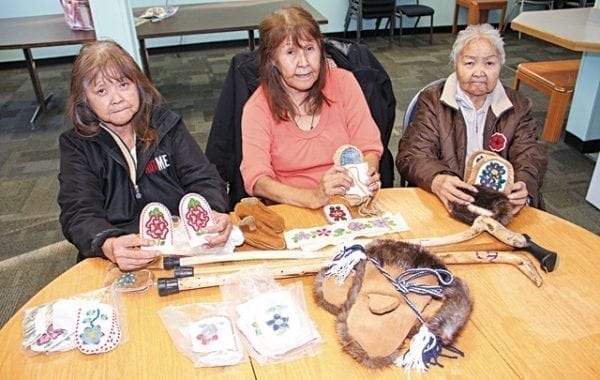A call is being raised on the Hay River Reserve for more support for craftspeople and artists.

"We have so many beautiful people that do beautiful work," said Georgina Fabian, while noting there is a lack of support, particularly from the Department of Industry, Tourism and Investment (ITI).
"Those people are getting paid from the government to say this is available," she said. "But I have never seen them come out and say, 'Hey people, let's have a day of what's available for you.'"
Rosa Sabourin also believes more support is needed.
"The money we get from ITI is not enough," she said. "The cost of the beads and the stroud and the moose hide it just doesn't cover, although we put our own money in there, too."
Sabourin also said craftspeople need more help to travel to promote and sell their creations.
Fabian agreed materials are very expensive.
"When you have to buy materials, you have to get genuine materials, she said. "A meter of stroud is probably about $40 or something."
Fabian said she wants people and the government to understand the problems faced by craftspeople.
"I just want them to hear our stories. What the artists go through," she said. "I enjoy what I do, that's me. This is my life."
Angie Sabourin, who is Rosa Sabourin's sister, would like to see an improved online presence for craftspeople, noting some are online and some are not.
"Because some friends of mine they get orders from Australia, and Paris. Everywhere," she said. "They get orders because they're on a website, but us, we're not."
Mostly, the three sell their crafts at flea markets and craft shows, although Fabian said she has also travelled to shows in Inuvik and Edmonton.
The artists also feel there should be more support from K'atlodeeche First Nation for the approximately 10 craftspeople on the Hay River Reserve.
In addition, Fabian believes craftspeople should get more consideration from buyers.
"The other thing, too, is people make orders and at the last minute they change their mind," she said. "You work on that stuff for a long time and then when you're just about ready sometimes they say, 'I just want to cancel my order.' So for myself, I've been doing that for a long time and finally one day I just said I'm not taking any more orders."
All three of the craftspeople agree they would like to receive more information from ITI about the support that is available.
Camilla MacEachern, the acting director of ITI's division of economic diversification, which oversees arts and crafts, said support for the arts and fine crafts industry is offered through her department and the Department of Education, Culture and Employment (ECE).
"ITI has programming under the Support for Entrepreneurs and Economic Development policy, calling that SEED," she said. "What that does is there is a fund under the microbusiness section of SEED. It supports local artists and fine crafters with the cost to produce their art. So, for instance, a crafter can come and access funding to purchase moose hides or to purchase materials to create artwork. It's a pot of funding that is $5,000 and that is available once every three years."
MacEachern said ITI is always interested in hearing from craftspeople to make sure that the program is working.
She noted the department also supports marketing and promotion.
"So there is funding available for artists to access to go attend shows and events," she said. "That's separate from the pot of funding of the $5,000."
ITI also manages an NWT arts database, which is a website that includes information on the types of art available in the NWT, who is producing the artwork and where it can be purchased.
"The goal is to be able to allow artists a free platform to promote themselves and then their careers, but to also package it to prospective art buyers and tourists who are coming into the territory and interested," MacEachern said. "So this is actually very unique and rare in that the Northwest Territories are one of the only jurisdictions that maintain a site like this."
The department also has an access to raw materials program that offers things such as beaver pelts and seal skins to artists at cost.
MacEachern noted ECE also supports the arts industry through the NWT Arts Council.
When told of the concerns on the Hay River Reserve, MacEachern noted programs are delivered at a regional level.
"So it most certainly is the responsibility of the GNWT and ITI to put on workshops and information sessions, which does happen on a regular basis," she said. "It sounds like the Hay River Reserve is due for another information session."
MacEachern said ITI staff would be happy to provide a workshop on the reserve.
According to the latest numbers, there are 734 artists, including craftspeople, registered with the GNWT.
Last year, ITI provided $1.6 million in funding to NWT artists.